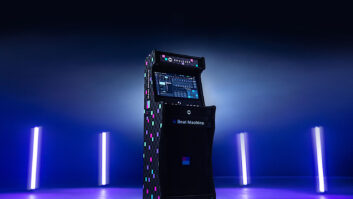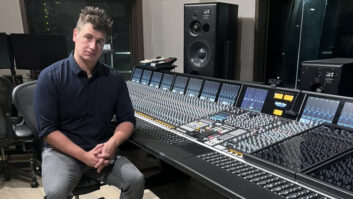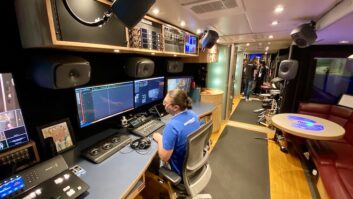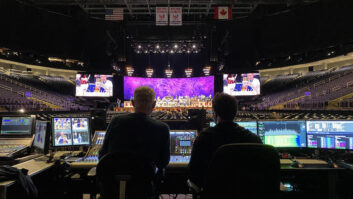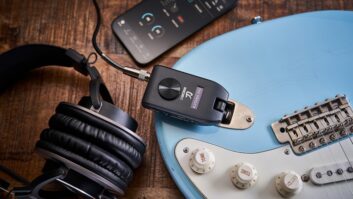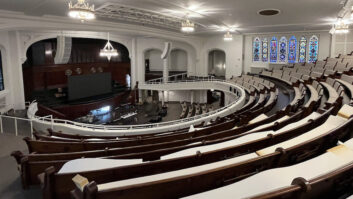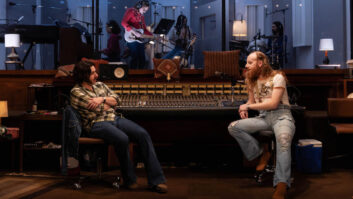A NEW MUSIC SHOW BOLDLY GOES WHERE NO SHOW HAS GONE BEFORE
Music in High Places is such a good idea, it’s a wonder no one has tried it before. The monthly series, which debuted last fall on DirecTV and has now been picked up by MTV, sends musicians to remote, exotic settings, follows them as they become immersed in the local culture and history, and then tapes them performing in these breathtaking, out-of-the-way places; it’s sort of a National Geographic Explorer meets MTV Unplugged.
Completed episodes so far have included Alanis Morissette in Navajo country—Canyon de Chelly and Monument Valley; multi-Platinum-selling soulster Brian McKnight in Sao Luis, Brazil (where he takes in a voodoo ceremony and visits the ruins of a one-time slave market); Wynonna Judd in Venice and the tiny nearby town of Fontenellato; Shawn Colvin in Tahiti and Bora Bora; and Collective Soul in Morocco. Future episodes involving the likes of Wyclef Jean, LeAnn Rimes, Moby and Sugar Ray will explore and feature music in other fascinating sites around the world. In all, the first season of MIHP will consist of 12 adventures, and, naturally, the producers, Tall Pony Productions of Malibu, Calif., are hoping to get the series picked up for more episodes that will take them to far-flung places such as Ayers Rock, Stonehenge, Angkor Wat, the Great Wall and Machu Picchu.
This series didn’t invent the notion of playing and recording music in historic settings and spiritually “high” places. Jazz flutist Paul Horn cut simple records in the Taj Mahal and the Grand Canyon decades ago. Pink Floyd filmed a concert (with no audience) in the ruins of Rome’s Colosseum 30 years ago. The Grateful Dead played three nights at the foot of the Great Pyramid in Gizeh back in 1978. A few years ago, Yanni played outside the Acropolis in his native Greece as a battery of video cameras and multitrack tape recorders captured the spectacle. But Music in High Places is marked by a relaxed intimacy; there are no crowds witnessing the performances. No theatrical lighting. We don’t even see any microphones. It’s just musicians, playing acoustic instruments in beautiful places. The audio quality is superb and the visuals stunning—no easy feat when you consider the hardships of working in remote environments.
Heading up the MIHP sound team is veteran engineer Don Worsham, who, over the course of 35 years in the entertainment industry, has been nominated for 21 Grammy Awards and won six for audio mixing. His credit list includes nearly two decades of contributing to Grammy telecasts, several Miss America pageants and dozens of television music specials in every genre. He has designed audio facilities and was instrumental in helping devise surround mixing standards for television. In short, he’s a good guy to have onboard for a challenging audio project, which MIHP certainly is.
“This particular show has been trying to hatch for a couple of years,” the gregarious Worsham says from his L.A.-area home between location shoots. “I’ve had a long, comfortable relationship with Tall Pony Productions. They mostly do music—they were responsible for the five years of the Sinbad Soul Music Festival on HBO, which I did, and the Radio Music Awards and the Burt Bacharach show [One Amazing Night] that was on TNT. They don’t do sitcoms, they don’t do documentaries. It tends to be very music-oriented, and it tends to be on location. In this particular case, they wanted to go on location, which I said was fine; we’ve done it a thousand times, no problem. But then they said, ‘We’re talking about really going on location. We’re not talking about taking trucks here. We’re talking about battery power, carrying stuff up cliffs.’ I said, ‘You’re kidding. You want to go out, have people perform, record essentially on no more than what people can carry, and we’re not going to be near power? No generators?’ ‘No generators.’
“The first two problems with this presented themselves simultaneously: One was putting a plan into place that would give the flexibility of recording these things to a standard that would allow post-production flexibility so that you can get it right. And then, secondly, it had to be done on battery power. Now, I’ve worked with a lot of budgets, but this was the first time I had a power budget. It had to be all portable batteries. So that then led us into a number of limited options. When we’re talking about a battery budget, we started working backwards: What are the batteries available, and how much power does that represent? And how long will that run? We ended up with a battery system that was 28 amp-hours at 12 volts. You do the mathematics—one amp-hour at nine volts is nine watts; volts times amps equals watts. Wattage is a description of the amount of energy a device requires to run, and, generally, it’s on an hourly basis. So we ended up with this wattage number, and then we had to find something that would work with that.
“One of the priorities of the production company is that they wanted to do a state-of-the-art digital recording on location,” he continues. “When we started looking at small digital consoles, we were looking at running just 45 minutes or an hour and then we were out of battery, which is not very good. Dragging around multitrack tape machines was out of the question because of size. So, naturally, we were then looking at modular digital multitracks, and we ended up with a DA-78 as opposed to anything else because it only draws 50 watts. Once you get a DA-88 to do all of the things a 78 can do, it draws twice as much power. The DA-78 has the built-in timecode generation, plus it gave us the opportunity to go 24-bit long word length, which gives us higher resolution audio in the field. Then the next question is, what do we feed it with? We knew there were a couple of digital mixers that were close, power-wise, but not close enough, so we ended up getting a Mackie 1604 VLZ Pro—lots of positions, direct outputs, very highly touted microphone preamps. So we could acquire this stuff out in the field, so to speak, and get it on tape cleanly. We generally have 8-in, 8-out, but we might have as many as 10 or 11 inputs, so we might do some sort of combine submix on something.
“The other thing that we’re using is a 4-track hard drive recorder by Zaxcom called Deva. This is a box with a 10-gig hard drive, and it can be configured as a 4-track, 24-bit recorder. We’ll use that as a 4-in, 4-out device where we can’t pull our regular gear along. It’s really small; only about 4-by-4. It’s got an interchangeable hard drive; it can be line- or mic-in; digital in, digital out. And what we’ll do with this is take four audio sources into the Deva, then take four line-level outputs from the Deva into a very small but high-quality mixer made by J.L. Cooper, the CS104—it’s a 4-in by 2-out model—and we use that to generate a stereo mix to videotape. We use it mostly in places where we don’t have the space or time to take the other stuff. But all of the Tahiti show was shot on the Deva. For Brian McKnight, we used it in the desert and at the slave quarters, straight to tape, 2-channel. On Wynonna, we used it for an a cappella performance in the church.
“So, for all that, we carry three battery sets that are good for 28 amp-hours. Two of them are single batteries, and then there’s a set that is four individual 7-amp batteries. At 100 watts an hour of power consumption, that gives us three hours. The Deva and the Cooper mixer use the small 7-amp batteries, so we have extended battery life on them. The Mackie has been modified to operate directly off of 12 volts. That’s helped us quite a bit. Between the Mackie and the tape machine, we’re right at 100 watts.”
Miking the performers presented another set of challenges, because the producers stipulated that they didn’t want to see any microphones. “Fortunately, I had some great help on this,” Worsham says, “a person I’ve worked with for years named Jeff Fecteau, who’s an accomplished musician and a great audio guy who I’ve worked with on a lot of music projects for television. Jeff is the kind of guy who can walk up to a musician on the stage and there is instant rapport. He knows the language. And, of course, he knows the technical end as well as anyone. Our problem here was how do we hide these mics and still have it sound good and not like it’s some kind of news show out in the field? So Jeff came up with some ideas, using straight-off-the-shelf gear and really careful microphone placement to get what we wanted.
“Obviously, we have to be wireless, so we were using Lectrosonic wireless systems, which I think are about the best of the battery-operated field wireless systems available. And we’re using a combination of lavalier microphones. We have some Trams, which are fairly popular and widely used. They’re physically flat, instead of being round; their size and shape make them very suitable for hiding under clothing. The response of these microphones has been specifically tailored with a presence boost in them to overcome being hidden under clothing. We’ve also been using Sennheiser K2 lavalier mics, which are similar to the ones that are used on the Broadway theater stage for voice. They’re very flat microphones, and they have very good reach. You can hide them in places that normally wouldn’t work well, yet they sound full and open. Then we have a new lavalier microphone from Shure, the WL50, which is small like the Sennheiser, and it sounds unbelievable—it is the cleanest, clearest microphone. It has an option that allows you to go with either flat response or peak response. It was used on the acoustic basses on Wynonna and for both the vocal and the acoustic guitar on Shawn Colvin, and it sounded great.”
Generally speaking, Fecteau will place a mic on the singer(s) and on each instrument; in the guitar’s sound hole, for example. Not surprisingly, there are leakage issues having microphones in such proximity, but as Worsham notes, “Not all leakage is bad leakage, and, in fact, on Shawn we tried to use the leakage to spread out the sound, because it’s just vocal and guitar. There was a lot of guitar in her vocal mic, but it was different than the sound in her guitar mic so we tried to use that to our advantage. We’ve shunned using pickups, because the guitar coming through the vocal mics gives us a more complementary sound. We’re looking for the essences and overtones and the subtleties that go beyond just the sound of the guitar.”
Additionally, wherever physically possible, the sound team puts up ambient mics to capture the overall sound of the performance and “to record the air, the space, to give a sense of where we are,” Worsham says. “So we’ll use a couple of Schoeps mics—sometimes we’re using straight X-Y crossed mics; in a couple of instances, we’ve used M-S, sum-difference, miking. And, in every instance, we’ve used them in the mix to give a sense of size and to give a feeling of air around what would otherwise be an extremely dry environment. Lavalier microphones on people outside are dead-dry. So part of our post-production is to not only put these ambient mics in to open up the mix, but also to put in a touch of any other additional ambiences we have—wind, birds, the sort of things we acquire as part of our production. We might also put a little reverb on it to try to tie it all together; it depends.” Worsham says that on location they also record hours of environmental sounds on an HHB DAT, using either the Schoeps mics, a Sennheiser 416 or Sennheiser 405, and there’s even been talk of releasing a CD of nature sounds culled from the series. Worsham also uses the DAT to pick up city ambiences as needed.
“In the Wynonna show,” he says, “they perform at a place called Domino Point, and it’s right at the end of the day and we do two or three takes and on one of the takes, the Saint Marco square bells ring. So I make a note that I have to come back and get the San Marco bells not only from this location, but from a couple of other places, too. Later, we were able to get back to Venice for another half a day, and I sat out on that point for an hour and a half with a DAT machine to get the right bells. So I’m waiting and then this helicopter hovers over the square for 20 minutes and I miss my first pass at the bells and I have to wait for the next one. Sure enough, we go into post and I’ve got two different performances, one with bells and one without bells, and we were able to put the bells in where there were no bells, so the texture of that presence is in there, even though the best performance we had on tape would not necessarily have given us the continuity of that.”
A typical shoot for the show is just three days, which means that logistics must be planned out carefully in advance, and then the actual work has to be done efficiently. In all, the audio and video teams travel with 1,500 pounds of gear in 29 cases—all just for audio. “Sometimes we’ve shipped it; sometimes we’ve taken it as baggage,” Worsham says. “When we go to the airport…well, we’re hard to miss,” he says with a laugh.
Usually there will be two or three takes of each song, with the cameras (usually three) moved between takes to add variety; then in the post stage, a seamless edit between performances is achieved. Worsham notes that besides the 4- or 8-track recording, “We also put a 2-track mix to videotape. My philosophy is that they’re going to go back and look at this thing, and they’re going to make editorial decisions based on what they hear, so it becomes important that there is something representative of what’s happening. Secondly, there’s always the possibility that what we’ve put on our multitrack medium is not usable for any reason. So far that hasn’t happened, but that has to be part of our concern—we’ve gone all the way to Brazil and I only did a so-so 2-track mix, and now it turns out the tapes don’t sound right or they won’t play, or whatever. I don’t want to face that. We’ve been very lucky so far. Everything has worked beautifully. We’ve had batteries die at the most awkward moments, but no equipment failures so far. As fragile as digital can be, we’ve dodged the bullet, so to speak.”
After the location shoot, the video post takes place on an Avid system in a Santa Monica facility called Chain-saw, while the audio is assembled by Worsham at The Post Group. “What we do,” he explains, “is take the Avid audio file—an OMF file—and transfer it into a Fairlight over at The Post Group. We conform everything else—which is our original location tracks, voice-overs, any additional incidental music, like themes, etc.—into the Fairlight, as well. The Fairlight is a phenomenal system in terms of its ability to edit and move things around. It’s pretty sharp. And we’re able to do things in the Fairlight as a full digital editing system that is also locked to picture and locked to timecode. It’s really like the extension of a Pro Tools into a picture format.
“But, because of the amount of material that is involved in each show, there is a realistic limitation to how much memory that the Fairlights can manage, so we’ve been doing the final mix into analog multitrack through the Neve at The Post Group. And one reason is we have a couple of versions of the show we have to do: There’s the standard air version and another for MSN—Microsoft has a Web site for the show [http://mu sicinhighplaces.msn.com] that has Windows Media files of the videos of the performances, without the voice-overs and some of the cutaways and things. They basically take performance only and put that on the Internet.” The MTV shows will also be slightly different, as the one-hour running time of each episode will probably be reduced by commercials and the inclusion of a short “making-of” segment each month.
Both the musicians and the technical personnel who work on Music in High Places seem to be enjoying themselves immensely. For the artists, it’s an opportunity to present their music in a different, very personal way: You’ve never heard Alanis Morissette’s music stripped so bare, and Wynonna’s small, gospel-influenced acoustic group is a wonderful revelation. Even Worsham, the old pro who’s seen and heard it all, is in awe of what he’s experiencing through the show.
“These artists really have got to have their chops down. There is no hiding. Every note you hear in that show has been performed right out there. Nobody’s gone in and fixed anything. The quality of what we were hearing—the artistic quality—is absolutely phenomenal. We’re talking about people who are at the top of what they do, and that makes it a lot of fun to work on.”
Blair Jackson is executive editor of Mix.
